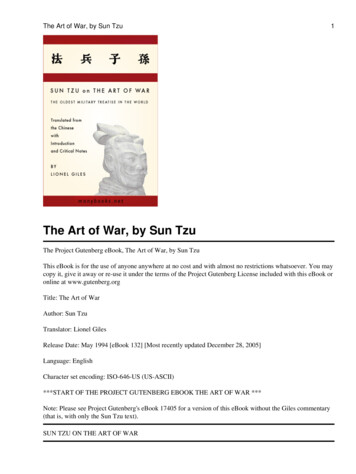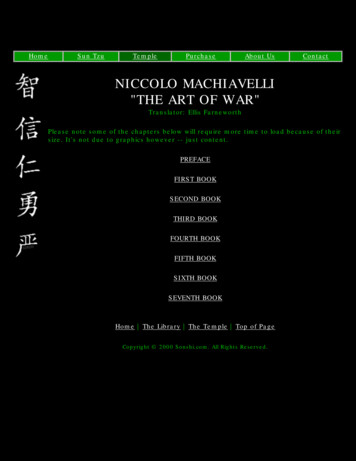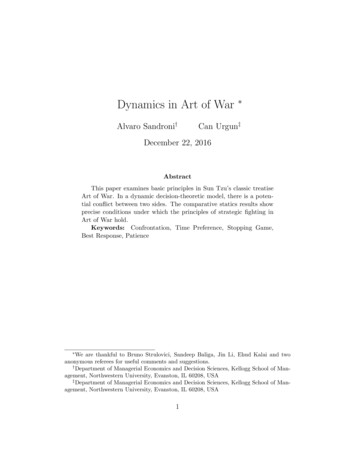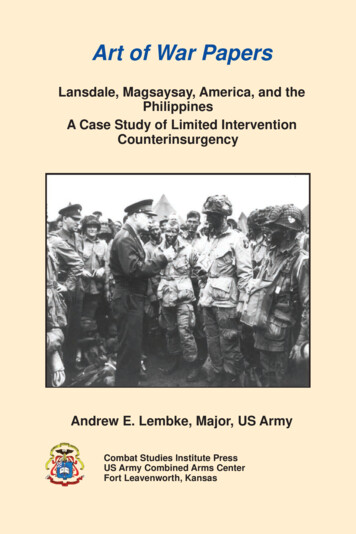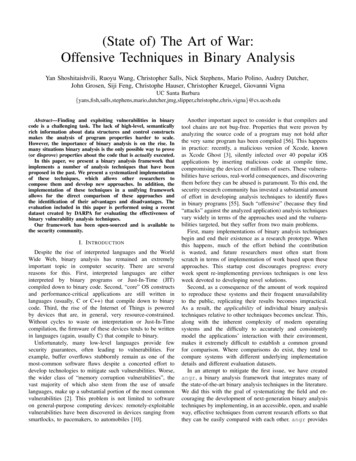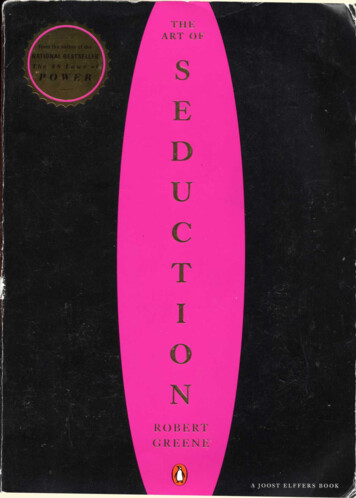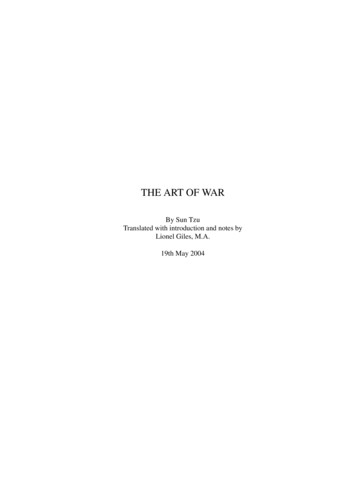
Transcription
THE ART OF WARBy Sun TzuTranslated with introduction and notes byLionel Giles, M.A.19th May 2004
Contents1INTRODUCTION1.1 Sun Wu and his Book . .1.2 The Text of Sun Tzu . .1.3 The Commentators . . .1.4 Appreciations of Sun Tzu1.5 Apologies for War . . . .44141620212LAYING PLANS283WAGING WAR324ATTACK BY STRATAGEM365TACTICAL DISPOSITIONS426ENERGY467WEAK POINTS AND STRONG528MANEUVERING599VARIATION IN TACTICS6810 THE ARMY ON THE MARCH7411 TERRAIN8512 THE NINE SITUATIONS9213 THE ATTACK BY FIRE11414 THE USE OF SPIES1201
CONTENTS2This Etext has been prepared and released by Project Gutenberg PROJECT GUTENBERG OFFICIALHOME SITE http://www.promo.net/pg/. Re-editing and conversion to LATEXformat independentlyfrom Project Gutenberg and/or previous editors by Tomas Ukkonen 2004. This etext is a “public domain”work. Editors disclaim all liability to you for damages, costs and expenses including legal fees, and YOUHAVE NO REMEDIES FOR NEGLIGENCE OR UNDER STRICT LIABILITY, OR FOR BREACH OFWARRANTY OR CONTRACT, INCLUDING, BUT NOT LIMITED TO INDIRECT, CONSEQUENTIAL,PUNITIVE OR INCIDENTAL DAMAGES, EVEN IF YOU GIVE NOTICE OF THE POSSIBILITY OFSUCH DAMAGES.
CONTENTS3To my brother Captain Valentine Giles, R.G. in the hope that a work 2400years old may yet contain lessons worth consideration by the soldier oftoday this translation is affectionately dedicated.Preface to the Project Gutenburg EtextWhen Lionel Giles began his translation of Sun Tzu’s ART OF WAR, the work wasvirtually unknown in Europe. Its introduction to Europe began in 1782 when a FrenchJesuit Father living in China, Joseph Amiot, acquired a copy of it, and translated it intoFrench. It was not a good translation because, according to Dr. Giles, "[I]t contains agreat deal that Sun Tzu did not write, and very little indeed of what he did."The first translation into English was published in 1905 in Tokyo by Capt. E. F.Calthrop, R.F.A. However, this translation is, in the words of Dr. Giles, "excessivelybad." He goes further in this criticism: "It is not merely a question of downright blunders, from which none can hope to be wholly exempt. Omissions were frequent; hardpassages were willfully distorted or slurred over. Such offenses are less pardonable.They would not be tolerated in any edition of a Latin or Greek classic, and a similarstandard of honesty ought to be insisted upon in translations from Chinese." In 1908a new edition of Capt. Calthrop’s translation was published in London. It was an improvement on the first – omissions filled up and numerous mistakes corrected – butnew errors were created in the process. Dr. Giles, in justifying his translation, wrote:"It was not undertaken out of any inflated estimate of my own powers; but I could nothelp feeling that Sun Tzu deserved a better fate than had befallen him, and I knew that,at any rate, I could hardly fail to improve on the work of my predecessors."Clearly, Dr. Giles’ work established much of the groundwork for the work of latertranslators who published their own editions. Of the later editions of the ART OF WARI have examined; two feature Giles’ edited translation and notes, the other two presentthe same basic information from the ancient Chinese commentators found in the Gilesedition. Of these four, Giles’ 1910 edition is the most scholarly and presents the readeran incredible amount of information concerning Sun Tzu’s text, much more than anyother translation.The Giles’ edition of the ART OF WAR, as stated above, was a scholarly work.Dr. Giles was a leading sinologue at the time and an assistant in the Department ofOriental Printed Books and Manuscripts in the British Museum. Apparently he wantedto produce a definitive edition, superior to anything else that existed and perhaps something that would become a standard translation. It was the best translation available for50 years. But apparently there was not much interest in Sun Tzu in English- speakingcountries since it took the start of the Second World War to renew interest in his work.Several people published unsatisfactory English translations of Sun Tzu. In 1944, Dr.Giles’ translation was edited and published in the United States in a series of militaryscience books. But it wasn’t until 1963 that a good English translation (by Samuel B.Griffith and still in print) was published that was an equal to Giles’ translation. Whilethis translation is more lucid than Dr. Giles’ translation, it lacks his copious notes thatmake his so interesting.
CONTENTS4Dr. Giles produced a work primarily intended for scholars of the Chinese civilization and language. It contains the Chinese text of Sun Tzu, the English translation, andvoluminous notes along with numerous footnotes. Unfortunately, some of his notes andfootnotes contain Chinese characters; some are completely Chinese. Thus, a conversion to a Latin alphabet etext was difficult. I did the conversion in complete ignoranceof Chinese (except for what I learned while doing the conversion). Thus, I faced thedifficult task of paraphrasing it while retaining as much of the important text as I could.Every paraphrase represents a loss; thus I did what I could to retain as much of the textas possible. Because the 1910 text contains a Chinese concordance, I was able to transliterate proper names, books, and the like at the risk of making the text more obscure.However, the text, on the whole, is quite satisfactory for the casual reader, a transformation made possible by conversion to an etext. However, I come away from this taskwith the feeling of loss because I know that someone with a background in Chinesecan do a better job than I did; any such attempt would be welcomed.Bob du
Chapter 1INTRODUCTION1.1Sun Wu and his BookSsu-ma Ch‘ien gives the following biography of Sun Tzu:1Sun Tzu Wu was a native of the Ch‘i State. His ART OF WAR broughthim to the notice of Ho Lu,2 King of Wu.Ho Lu said to him: "I have carefully perused your 13 chapters. May Isubmit your theory of managing soldiers to a slight test?"Sun Tzu replied: "You may."Ho Lu asked: "May the test be applied to women?"The answer was again in the affirmative, so arrangements were made tobring 180 ladies out of the Palace. Sun Tzu divided them into two companies, and placed one of the King’s favorite concubines at the head ofeach. He then bade them all take spears in their hands, and addressedthem thus: "I presume you know the difference between front and back,right hand and left hand?"The girls replied: Yes.Sun Tzu went on: "When I say "Eyes front," you must look straight ahead.When I say "Left turn," you must face towards your left hand. When I say"Right turn," you must face towards your right hand. When I say "Aboutturn," you must face right round towards your back."Again the girls assented. The words of command having been thus explained, he set up the halberds and battle-axes in order to begin the drill.Then, to the sound of drums, he gave the order "Right turn." But the girlsonly burst out laughing. Sun Tzu said: "If words of command are not clearand distinct, if orders are not thoroughly understood, then the general is toblame."1 SHI2 HeCHI, ch. 65.reigned from 514 to 496 B.C.5
CHAPTER 1. INTRODUCTION6So he started drilling them again, and this time gave the order "Left turn,"whereupon the girls once more burst into fits of laughter. Sun Tzu: "Ifwords of command are not clear and distinct, if orders are not thoroughlyunderstood, the general is to blame. But if his orders ARE clear, and thesoldiers nevertheless disobey, then it is the fault of their officers."So saying, he ordered the leaders of the two companies to be beheaded.Now the king of Wu was watching the scene from the top of a raisedpavilion; and when he saw that his favorite concubines were about to beexecuted, he was greatly alarmed and hurriedly sent down the followingmessage: "We are now quite satisfied as to our general’s ability to handletroops. If We are bereft of these two concubines, our meat and drink willlose their savor. It is our wish that they shall not be beheaded."Sun Tzu replied: "Having once received His Majesty’s commission tobe the general of his forces, there are certain commands of His Majestywhich, acting in that capacity, I am unable to accept."Accordingly, he had the two leaders beheaded, and straightway installedthe pair next in order as leaders in their place. When this had been done,the drum was sounded for the drill once more; and the girls went throughall the evolutions, turning to the right or to the left, marching ahead orwheeling back, kneeling or standing, with perfect accuracy and precision,not venturing to utter a sound. Then Sun Tzu sent a messenger to the Kingsaying: "Your soldiers, Sire, are now properly drilled and disciplined, andready for your majesty’s inspection. They can be put to any use that theirsovereign may desire; bid them go through fire and water, and they willnot disobey."But the King replied: "Let our general cease drilling and return to camp.As for us, We have no wish to come down and inspect the troops."Thereupon Sun Tzu said: "The King is only fond of words, and cannottranslate them into deeds."After that, Ho Lu saw that Sun Tzu was one who knew how to handle anarmy, and finally appointed him general. In the west, he defeated the Ch‘uState and forced his way into Ying, the capital; to the north he put fearinto the States of Ch‘i and Chin, and spread his fame abroad amongst thefeudal princes. And Sun Tzu shared in the might of the King.About Sun Tzu himself this is all that Ssu-ma Ch‘ien has to tell us in this chapter. Buthe proceeds to give a biography of his descendant, Sun Pin, born about a hundred yearsafter his famous ancestor’s death, and also the outstanding military genius of his time.The historian speaks of him too as Sun Tzu, and in his preface we read: "Sun Tzuhad his feet cut off and yet continued to discuss the art of war."3 It seems likely, then,that "Pin" was a nickname bestowed on him after his mutilation, unless the story wasinvented in order to account for the name. The crowning incident of his career, the3 SHICHI, ch. 130.
CHAPTER 1. INTRODUCTION7crushing defeat of his treacherous rival P‘ang Chuan, will be found briefly related inChapter V. ss. 19, note.To return to the elder Sun Tzu. He is mentioned in two other passages of the SHIHCHI:In the third year of his reign [512 B.C.] Ho Lu, king of Wu, took thefield with Tzu-hsu [i.e. Wu Yuan] and Po P‘ei, and attacked Ch‘u. Hecaptured the town of Shu and slew the two prince’s sons who had formerlybeen generals of Wu. He was then meditating a descent on Ying [thecapital]; but the general Sun Wu said: "The army is exhausted. It is notyet possible. We must wait". [After further successful fighting,] "in theninth year [506 B.C.], King Ho Lu addressed Wu Tzu-hsu and Sun Wu,saying: "Formerly, you declared that it was not yet possible for us to enterYing. Is the time ripe now?" The two men replied: "Ch‘u’s general Tzuch‘ang, 4 is grasping and covetous, and the princes of T‘ang and Ts‘ai bothhave a grudge against him. If Your Majesty has resolved to make a grandattack, you must win over T‘ang and Ts‘ai, and then you may succeed."Ho Lu followed this advice, [beat Ch‘u in five pitched battles and marchedinto Ying.]5This is the latest date at which anything is recorded of Sun Wu. He does not appear tohave survived his patron, who died from the effects of a wound in 496.In another chapter there occurs this passage:6From this time onward, a number of famous soldiers arose, one after theother: Kao-fan,7 who was employed by the Chin State; Wang-tzu,8 in theservice of Ch‘i; and Sun Wu, in the service of Wu. These men developedand threw light upon the principles of war.It is obvious enough that Ssu-ma Ch‘ien at least had no doubt about the reality of SunWu as an historical personage; and with one exception, to be noticed presently, he isby far the most important authority on the period in question. It will not be necessary,therefore, to say much of such a work as the WU YUEH CH‘UN CH‘IU, which issupposed to have been written by Chao Yeh of the 1st century A.D. The attribution issomewhat doubtful; but even if it were otherwise, his account would be of little value,based as it is on the SHIH CHI and expanded with romantic details. The story of SunTzu will be found, for what it is worth, in chapter 2. The only new points in it worthnoting are: (1) Sun Tzu was first recommended to Ho Lu by Wu Tzu-hsu. (2) He iscalled a native of Wu. (3) He had previously lived a retired life, and his contemporarieswere unaware of his ability.The following passage occurs in the Huai-nan Tzu: "When sovereign and ministersshow perversity of mind, it is impossible even for a Sun Tzu to encounter the foe."4 Theappellation of Nang Wa.CHI, ch. 31.6 SHI CHI, ch. 25.7 The appellation of Hu Yen, mentioned in ch. 39 under the year 637.8 Wang-tzu Ch‘eng-fu, ch. 32, year 607.5 SHI
CHAPTER 1. INTRODUCTION8Assuming that this work is genuine (and hitherto no doubt has been cast upon it), wehave here the earliest direct reference for Sun Tzu, for Huai-nan Tzu died in 122 B.C.,many years before the SHIH CHI was given to the world.Liu Hsiang (80-9 B.C.) says: "The reason why Sun Tzu at the head of 30,000 menbeat Ch‘u with 200,000 is that the latter were undisciplined."Teng Ming-shih informs us that the surname "Sun" was bestowed on Sun Wu’sgrandfather by Duke Ching of Ch‘i [547-490 B.C.]. Sun Wu’s father Sun P‘ing, roseto be a Minister of State in Ch‘i, and Sun Wu himself, whose style was Ch‘ang-ch‘ing,fled to Wu on account of the rebellion which was being fomented by the kindred ofT‘ien Pao. He had three sons, of whom the second, named Ming, was the father of SunPin. According to this account then, Pin was the grandson of Wu, which, consideringtha
The Giles’ edition of the ART OF WAR, as stated above, was a scholarly work. Dr. Giles was a leading sinologue at the time and an assistant in the Department of Oriental Printed Books and Manuscripts in the British Museum. Apparently he wanted to produce a definitive edition, superior to anything else that existed and perhaps some- thing that would become a standard translation. It was the .
